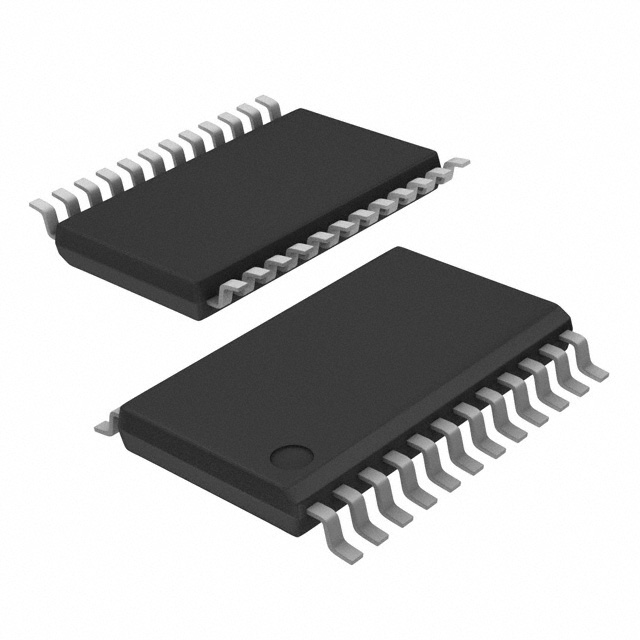PCF8575PWG4
Product Overview
- Category: Integrated Circuit (IC)
- Use: I/O Expander
- Characteristics: 16-bit remote I/O expander for I2C-bus with interrupt
- Package: TSSOP-24
- Essence: The PCF8575PWG4 is a versatile integrated circuit that expands the number of input/output (I/O) pins available to a microcontroller or other digital device. It communicates with the host device through the I2C-bus, providing an easy and efficient way to increase the I/O capabilities of a system.
- Packaging/Quantity: The PCF8575PWG4 is typically sold in reels or tubes, with a quantity of 250 units per reel/tube.
Specifications
- Supply Voltage Range: 2.5V to 6V
- Input/Output Voltage Range: 0V to VDD
- Maximum Output Current: 25mA per I/O pin
- Operating Temperature Range: -40°C to +85°C
- I2C-bus Interface: Compatible with I2C Fast-mode, Standard-mode, and SMBus protocols
- Interrupt Output: Open-drain active-low interrupt output
Detailed Pin Configuration
The PCF8575PWG4 has a total of 24 pins, which are assigned as follows:
- SDA: Serial Data Input/Output
- SCL: Serial Clock Input
- A0: Address Bit 0
- A1: Address Bit 1
- A2: Address Bit 2 6-21: I/O0-I/O15: General-purpose Input/Output Pins 22: INT: Interrupt Output 23: GND: Ground 24: VDD: Supply Voltage
Functional Features
- Remote I/O Expansion: The PCF8575PWG4 provides 16 additional I/O pins that can be controlled by a microcontroller or other digital device.
- Interrupt Functionality: The interrupt output pin (INT) can be used to notify the host device of changes in the input states, reducing the need for continuous polling.
- Low Power Consumption: The PCF8575PWG4 is designed to operate with low power consumption, making it suitable for battery-powered applications.
- I2C-bus Compatibility: The device supports various I2C-bus protocols, allowing easy integration into existing systems.
Advantages and Disadvantages
Advantages: - Increased I/O Capability: The PCF8575PWG4 expands the number of available I/O pins, enabling the connection of more devices or sensors. - Simplified Design: By offloading I/O functions to the PCF8575PWG4, the complexity of the main microcontroller's design can be reduced. - Cost-effective Solution: Using the PCF8575PWG4 eliminates the need for additional microcontrollers or complex circuitry, resulting in cost savings.
Disadvantages: - Limited Output Current: Each I/O pin has a maximum output current of 25mA, which may not be sufficient for some high-power applications. - Dependency on I2C-bus: The PCF8575PWG4 relies on the I2C-bus for communication, which may introduce latency or compatibility issues in certain scenarios.
Working Principles
The PCF8575PWG4 operates as an I/O expander by communicating with the host device through the I2C-bus. It uses a combination of address bits (A0, A1, A2) to assign a unique address to each device on the bus. The host device can then send commands and data to the PCF8575PWG4 to control its I/O pins.
When an input pin is configured, the PCF8575PWG4 can detect changes in the input state and generate an interrupt signal on the INT pin. This allows the host device to respond promptly to events without continuously polling the inputs.
Detailed Application Field Plans
The PCF8575PWG4 finds applications in various fields, including:
- Industrial Automation: It can be used to expand the I/O capabilities of programmable logic controllers (PLCs) or industrial control systems.
- Home Automation: The PCF8575PWG4 enables the connection of multiple sensors, switches, or actuators in smart home applications.
- Automotive Electronics: It can be utilized for expanding I/O in automotive control modules or infotainment systems.
- Internet of Things (IoT): The PCF8575PWG4 facilitates the integration of additional sensors or actuators in IoT devices.
- Robotics: It can be employed to increase the number of I/O pins available for controlling robot peripherals or sensors.
Detailed and Complete Alternative Models
- MCP23017: 16-bit I/O expander with I2C-bus/SPI interface
Lista 10 Vanliga frågor och svar relaterade till tillämpningen av PCF8575PWG4 i tekniska lösningar
Sure! Here are 10 common questions and answers related to the application of PCF8575PWG4 in technical solutions:
Q: What is PCF8575PWG4? A: PCF8575PWG4 is an I/O expander integrated circuit (IC) that provides additional input/output ports for microcontrollers or other digital devices.
Q: How many I/O ports does PCF8575PWG4 provide? A: PCF8575PWG4 provides a total of 16 I/O ports, which can be configured as either inputs or outputs.
Q: What is the voltage range supported by PCF8575PWG4? A: PCF8575PWG4 supports a wide voltage range from 2.3V to 5.5V, making it compatible with various microcontroller systems.
Q: Can PCF8575PWG4 handle both analog and digital signals? A: No, PCF8575PWG4 is designed specifically for digital signals and cannot handle analog signals directly.
Q: How do I communicate with PCF8575PWG4? A: PCF8575PWG4 uses the I2C communication protocol, allowing you to interface it with microcontrollers or other devices supporting I2C.
Q: Can I use multiple PCF8575PWG4 ICs in my project? A: Yes, you can connect multiple PCF8575PWG4 ICs together on the same I2C bus, expanding the number of available I/O ports.
Q: What is the maximum current that each I/O port of PCF8575PWG4 can sink/source? A: Each I/O port of PCF8575PWG4 can sink/source up to 25mA of current.
Q: Can PCF8575PWG4 handle high-speed applications? A: PCF8575PWG4 is not designed for high-speed applications as it operates at a maximum clock frequency of 400kHz.
Q: Is PCF8575PWG4 compatible with both 3.3V and 5V microcontrollers? A: Yes, PCF8575PWG4 is compatible with both 3.3V and 5V microcontrollers, thanks to its wide voltage range support.
Q: What are some common applications of PCF8575PWG4? A: PCF8575PWG4 is commonly used in applications such as keypad interfaces, LED displays, digital sensors, and general-purpose I/O expansion.
Please note that these answers are general and may vary depending on the specific implementation and requirements of your project.


